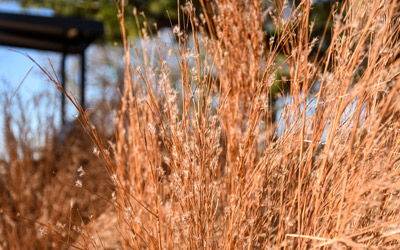The longest, darkest, coldest season is upon us. If you’re not a winter lover, your garden can help get you through it if you design with winter in mind. What you need are plants with winter interest.

Among gardeners and horticulturists, the term “winter interest” describes plants that offer a sensory, often visual, appeal after leaves have fallen, flowers have passed, and the New England landscape has gone grey. In our most recent “Gardening Central Mass” column with Worcester’s Telegram & Gazette, Director of Horticulture Mark Richardson describes how to plan a winter garden by specifically incorporating plants with elegant forms, evergreen foliage, and intriguing bark.
Gardens full of plants with winter interest offer color and beauty at a time when we need it most. But beauty, as the saying goes, is in the eye of the beholder.
Winter interest looks like standing deadwood to the pileated woodpeckers that call the Garden home. North America’s largest woodpecker finds leafless rotting trees so appealing because inside these trees delicious carpenter ants whittle away at decaying wood. The Garden’s Inner Park, an expanse of mixed-hardwood forest managed with ecologically minded practices, offers ready meals and an ideal habitat for pileated woodpeckers. Centuries of widespread forest clearing drove pileated woodpecker populations into sharp decline, but populations have rebounded in recent decades. Winter is a good time to look out or listen for these flashy, red-capped birds. Though still somewhat rare, they are easier to spot without summertime foliage to hide them from view.
For eastern bluebirds, trees and shrubs featuring colorful berries are a must when it comes to winter interest plants. Eastern red cedar, dogwood, sumac, and holly offer fruit that fuel these birds through the cold season when insects, their typical food source, are no longer available. While many eastern bluebirds migrate to warmer climates in winter, small flocks stick around in places where they can find secure habitat. This shift in migratory behavior has been documented among other birds like robins. Once considered the sign of spring in Massachusetts, robins can now be found in the Bay State year-round. Look for the Garden’s resident flock of bluebirds near the Apple Orchard or foraging berries from the hollies and dogwood of the Lawn Garden or Winter Garden.

Little bluestem (Schizachyrium scoparium) tops charts if you’re a black-capped chickadee or dark-eyed junco. This native, warm-season grass offers a wealth of oil-rich seeds for small birds to feast on. And because little bluestem grows in dense clumps, it provides protective habitat where birds and small mammals can shelter from the cold or winter storms. Because of its ecological value and understated beauty, little bluestem is a Garden favorite. You can find little bluestem planted in The Court, along the transition between the Vegetable Garden and Lawn Garden, and the Garden of Inspiration. We also have bits of naturally occurring schizachyrium in front of the Inner Park.
In the New Year, don’t miss opportunities to experience winter wonders at the Garden from wildlife watching to photography classes, workshops, exhibitions, and more. While a garden in winter may be frozen, it remains full of life, and from any perspective, full of interest.
—Liz Nye, New England Botanic Garden, December 2022
